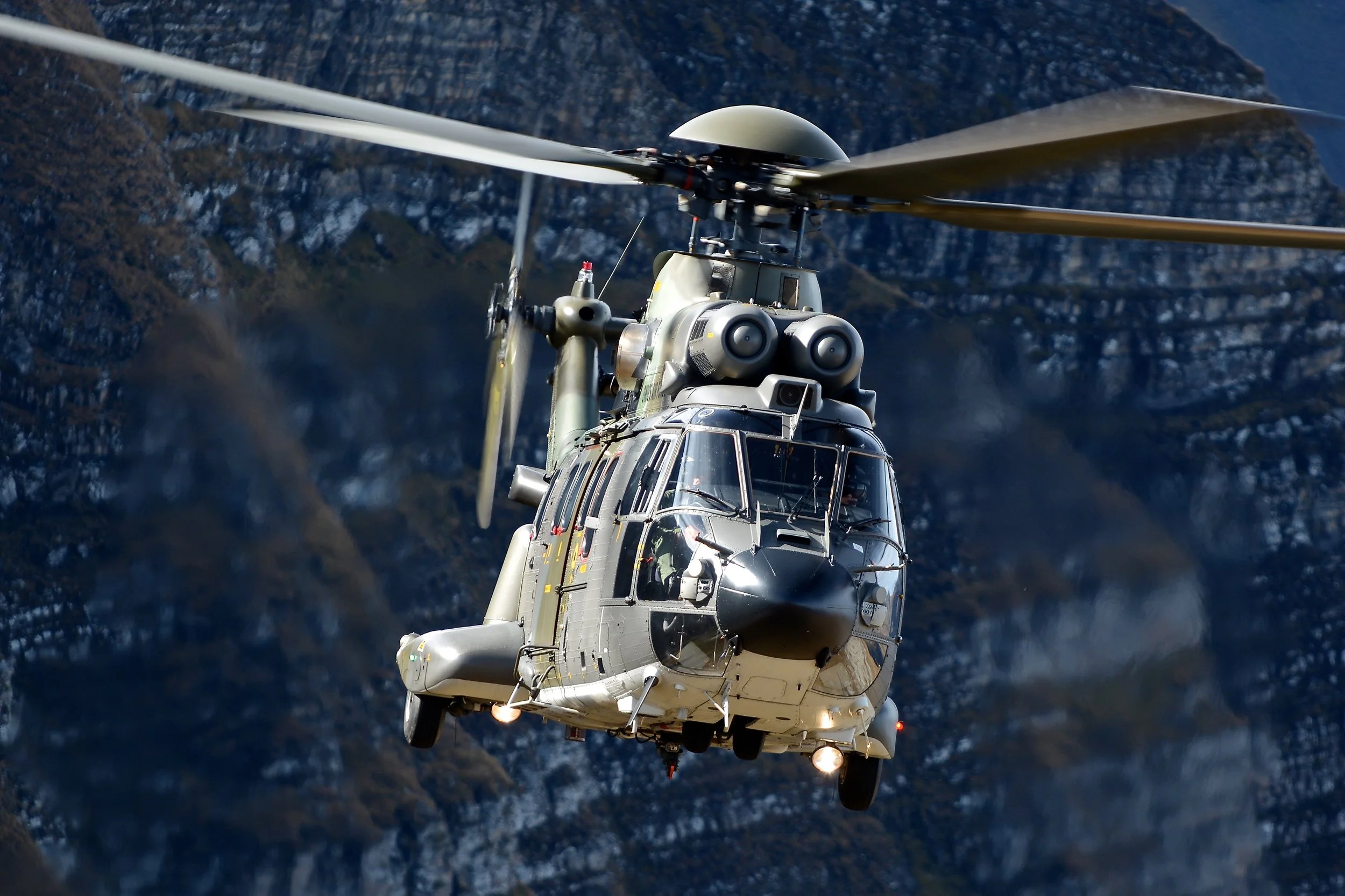
September 13 / Eurocopter AS332 Super Puma first flight
First Flight 13 September 1978
Eurocopter AS332 Super Puma
The Super Puma is a twin-engine medium-lift helicopter that has made a significant impact in both military and civilian aviation since its introduction in the 1970s. Developed by the French aerospace company Aérospatiale, the Super Puma was designed to meet the increasing demands for versatile and reliable rotorcraft capable of performing a wide range of missions, from troop transport to search and rescue operations.
The origins of the Super Puma can be traced back to the earlier Aérospatiale SA 330 Puma, which first flew in 1965. The Puma was a highly successful design that quickly gained a reputation for its robustness and versatility, serving various military and civilian applications around the world. As the helicopter industry evolved and the demands for more advanced capabilities grew, Aérospatiale recognized the need to develop a more modern and capable version of the Puma to meet these challenges.
In the early 1970s, Aérospatiale began working on an upgraded version of the Puma, which would incorporate advanced technologies and design features to enhance performance, efficiency, and operational flexibility. The result was the Super Puma, officially designated the AS332. The helicopter made its first flight on April 13, 1978, showcasing a range of improvements over its predecessor, including more powerful engines, a larger cabin, and enhanced avionics.
One of the standout features of the Super Puma is its twin-engine configuration, which provides increased power and redundancy compared to single-engine helicopters. This design choice not only enhances safety but also allows the Super Puma to carry heavier payloads and operate in a wider range of conditions. The helicopter is powered by two Turbomeca Makila engines, which provide excellent performance and reliability. The Super Puma can carry up to 24 passengers or a significant amount of cargo, making it suitable for various missions, including troop transport, medical evacuation, and logistical support.
The Super Puma was designed with versatility in mind. Its spacious cabin can be configured for different roles, including troop transport, cargo hauling, and even offshore oil and gas operations. The helicopter’s large sliding doors facilitate quick loading and unloading, while its external cargo hooks enable it to carry bulky loads. This adaptability has made the Super Puma a popular choice for military forces and civilian operators alike.
The Super Puma quickly gained traction among military operators, with the French Armed Forces being one of its first users. The French military utilized the helicopter for a variety of missions, including troop transport, search and rescue, and medical evacuation. Its performance in various operational scenarios solidified its reputation as a reliable and capable platform.
As the Super Puma entered service, it was adopted by several other countries, further expanding its reach. The helicopter became a favourite among NATO forces and was used in numerous peacekeeping and humanitarian missions around the world. Its ability to operate in diverse environments, from rugged mountainous terrain to harsh maritime conditions, made it an invaluable asset for military operations.
In addition to its military applications, the Super Puma also found success in the civilian sector. Its versatility made it an ideal choice for offshore oil and gas operations, where it was used to transport personnel and supplies to and from drilling rigs and platforms. The helicopter’s ability to operate in adverse weather conditions and its spacious cabin made it a preferred option for companies operating in the energy sector.
Over the years, the Super Puma underwent several upgrades and modifications to keep pace with advancements in technology and changing operational requirements. The AS332L1 and AS332L2 variants were introduced, featuring improved avionics, enhanced performance, and increased payload capabilities. These upgrades ensured that the Super Puma remained competitive in an evolving market and continued to meet the needs of its operators.
The Super Puma’s operational history is not without its challenges. The helicopter has faced scrutiny due to a number of accidents and incidents over the years, particularly in the civilian sector. These events prompted discussions about safety standards and operational practices, leading to improvements in training and maintenance procedures. The manufacturers and operators worked diligently to address these concerns, ensuring that the Super Puma maintained its reputation for reliability and safety.
As the 21st century progressed, the Super Puma continued to evolve. The helicopter was further modernized with the introduction of the H225 Super Puma, which incorporated advanced technologies and design features to enhance its capabilities. The H225 variant has been used in various roles, including search and rescue, law enforcement, and offshore operations, demonstrating the helicopter’s adaptability to modern mission profiles.
The Super Puma’s legacy is marked by its extensive service in both military and civilian roles around the world. It has seen action in various conflicts, humanitarian missions, and disaster relief operations, showcasing its versatility and reliability in diverse environments. The helicopter has become a symbol of modern rotorcraft design, reflecting the advancements in technology and engineering that have defined the aviation industry over the past several decades.
Today, the Super Puma remains in service with numerous military and civilian operators across the globe. Its enduring popularity is a testament to its design, performance, and adaptability. The helicopter’s ability to perform a wide range of missions has solidified its place in the history of aviation, ensuring that it will continue to play a vital role in both military and civilian operations for years to come.
In conclusion, the Super Puma is more than just a helicopter; it is a representation of the evolution of rotorcraft design and the changing needs of military and civilian aviation. Its development from the original Puma to the modern Super Puma and H225 variants reflects the ongoing pursuit of innovation and excellence in the aerospace industry. The Super Puma’s legacy is one of versatility, reliability, and performance, making it a cherished asset for operators around the world and a significant chapter in the story of modern aviation.
Super Puma Facts
Origins in the 1970s: The Super Puma was developed from the earlier Aerospatiale SA 330 Puma, which first flew in 1965. The Super Puma variant was introduced in the late 1970s, featuring significant upgrades in technology and performance.
Two Main Variants: The Super Puma family includes two main variants: the AS332 Super Puma and the EC225 Super Puma (also known as the H225). Each variant has its own set of enhancements and specific roles, such as offshore transport and military operations.
Advanced Avionics: The Super Puma is equipped with advanced avionics systems, including digital flight control systems, multi-functional displays, and integrated navigation systems, enhancing its operational capabilities and safety.
Versatile Roles: The helicopter is used in a wide range of roles, including troop transport, medical evacuation, search and rescue, offshore oil and gas support, and disaster relief operations. This versatility has made it a popular choice for various operators worldwide.
Capacity and Range: The Super Puma can typically carry up to 24 passengers or a payload of around 4,500 kg (approximately 10,000 lbs). Its range can exceed 800 kilometres (about 500 miles), depending on the configuration and mission profile.
Dual-Engine Design: The Super Puma features two Turbomeca Makila engines, providing redundancy and increased power. This dual-engine design contributes to its reliability and performance in challenging conditions.
Search and Rescue Operations: The Super Puma is often used in search and rescue (SAR) missions due to its ability to operate in adverse weather conditions. It can be equipped with specialized SAR equipment, such as hoists and medical facilities.
Military Variants: Many countries have adopted military variants of the Super Puma, including the AS532 Cougar. These variants are equipped with military-specific systems, such as armour, advanced avionics, and weaponry for combat support roles.
Global Presence: The Super Puma family has been adopted by numerous countries around the world, including France, the United Kingdom, Brazil, and South Africa. Its global presence is a testament to its reliability and versatility.
Continuous Upgrades: The Super Puma has undergone several upgrades over the years, including improvements in avionics, engines, and performance capabilities. The EC225, for example, features enhanced safety systems and improved fuel efficiency.












